


Bugging
You?
Bees & Wasps
We treat a range of stinging insects, including bald-faced hornets, yellow jackets, paper wasps, carpenter bees, mud-dauber wasps, European hornets, and bumble bees. Each singing insect is unique and finds a different way to invade your home or outdoor living space. Nesting sites include aerial nests in trees, ground holes, and wall penetrations via exterior cracks and unsealed gaps.
Effective control by the homeowner is unlikely due to the sheer number of occupants in the nest, misuse of products or improper control methods, the fear of being stung, and the medical concerns that may arise. All valid reasons to have Apex handle all your wasp, bee nest removal, and other stinging insect removal services. Besides eliminating individual nests, we use a specially formulated exterior power spray to prevent stinging insects in the first place so that you can enjoy your outside living space.
This preventative treatment discourages stinging insects from nesting or drilling into your home or business and eliminates any nests that have already formed. Our experienced wasp nest removal company will provide a crack and crevice, spot-specific exterior application to potential harborage sites from the roofline down. Any issues arising after treatment are guaranteed until the year’s first frost. Call the exterminators at Apex today.
Bee and Wasp Identification
Stinging insects can be nasty pests, so identifying what is plaguing you is the key to eradication. The bald-faced hornet, carpenter bee, yellow jacket wasp, paper wasp, mud dauber wasp, and bumble bee are common wasp pests.
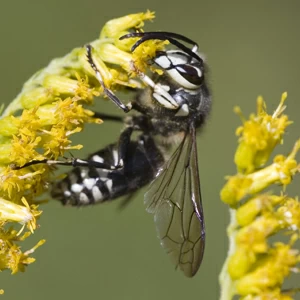
Bald-Faced Hornet
Identification Tips:
- Color: Largely black with white face
- Legs: 6
- Size: Adults are 5/8 to 7/8 inches long; Queens are about 3/4 to 1 1/8 inches long
- Identifying Characteristics: Colored black with a white pattern on the face, white stripes on the thorax and white bands on last three abdominal segments; construct aerial nests
Characteristics of this insect:
- Social insects consist of workers that are sterile females, queens who are the fertile females, and males that appear in later summer from unfertilized eggs
- Live in aerial nests. They attach nests to low shrubs, high trees, or high buildings. Nests are not reused the following season.
- Nest size varies from less than 2000 cells to 3500 cells that, contain 100 to 400 workers at its peak. At the end of the season, the founding queen (not the newly emerged queens and males that left the nest and mate), workers, and males all die.
- Only the inseminated queen overwinters and, in the spring, builds a grayish paper nest shaped like an inverted pear. One egg is laid in each cell, and the queen initially feeds on developing larvae chewed up insects, spiders, and nectar. By late September, the nests consist of 3 to 5 disk-like paper combs attached one below the other and encased in a multi-layered envelope.
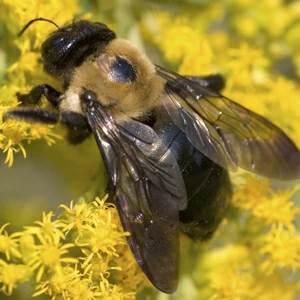
Carpenter Bee
Identification Tips:
- Color: Resemble the bumblebee, except that bumblebees have dense yellow and black hairs on the abdomen and large pollen baskets on hind legs, while carpenter bees have a nearly naked black, shiny abdomen
- Legs: 6
- Size: Adults are about 1 inch long
- Identifying Characteristics: Shiny, black abdomen; seen hovering around weathered and unpainted woods; although they will nest in a wide range of woods, they prefer softwoods such as cedar, redwood, cypress, pine, and fir
Characteristics of this insect:
- Solitary insects that do not form colonies. Usually are nuisance pests that cause cosmetic instead of structural damage. Considerable wood damage can occur as a result of many generations enlarging existing galleries in the wood
- Male and female carpenter bees overwinter in old nest galleries, emerging in the spring to mate
- The female prefers to utilize existing holes instead of excavating a new one. When constructing a new nest, the female utilizes strong jaws to excavate a clean-cut, 1/2-inch wide entrance hole. The hole is perpendicular to the grain for one to two inches, then makes a right-angle turn (90 degrees) and excavates along the wood grain for four to six inches or more to create a gallery (tunnel)
- The gallery will consist of six to ten eggs that are sectioned off and laid upon a mixture of pollen and regurgitated nectar to feed upon. The female carpenter bee will die soon after
- The new adults remain in the gallery for several weeks, chew through the partition, and venture outside in late August.

Yellow Jacket Wasp
Identification Tips:
- Color: Typical black and yellow color pattern
- Legs: 6
- Size: Adults are 3/8 to 3/4 inches long; Queens about 25% larger
Characteristics of this insect:
- Social insects consist of workers that are sterile females, queens who are the fertile females, and males that appear in later summer from unfertilized eggs
- Only the inseminated queen overwinters and, in the spring, uses chewed cellulose material to build up a paper carton or bag nest of few cells. One egg is laid in each cell, and the queen initially feeds on developing larvae chewed up insects, spiders, and nectar. Nests are constructed in attics, eves, soffits, gaps in exterior construction, false ceilings, and exterior rodent burrows, to name a few.
- Nest size varies from 300 to 120,000 cells, averaging 2,000 to 6,000 cells, which contain 1,000 to 4,000 workers at their peak
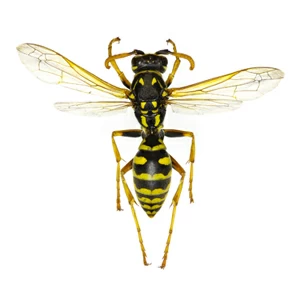
Paper Wasp
Identification Tips:
- Color: Yellow with rusty brown or black stripes
- Legs: 6
- Size: 5/8-3/4 inches
- Identifying Characteristics: Can range from dark brown, with black wings and yellow markings, to looking just like yellow jackets in coloration
Characteristics of this insect:
- Paper wasp nests are made from plant material combined with saliva to resemble gray paper-like material
- Nests consist of a single layer of paper-like comb with cells pointing downward, which are not enclosed. Nests hang from branches of trees or shrubs, porch ceilings, top of window or door frames, soffits, eaves, and deck railings, to name a few.
- Nests are not reused the following season.
- The wasps attack when aggravated and have a pretty painful sting. The insect does not lose its stinger so the wasps can sting several times. The females have a nasty sting that can threaten those allergic to wasp venom.

Mud Dauber Wasp
Identification Tips:
- Color: Black or metallic bluish-black with pale to yellow markings
- Legs: 6
- Size: Adults are 1 to 1 1/8 inches long
Characteristics of this insect:
- Not social wasps and do not live in colonies
- Mud daubers overwinter as full-grown larvae, pupate in the spring, and emerge shortly after that
- Females construct nests of mud. The nest comprises a series of cylindrical cells plastered over to form a soft nest.
- Females capture several spiders, stung and paralyzed, and used as a food source for brood. A single egg is deposited on the prey in each cell. The hatching larvae will eat the game and emerge from the nest.
- The nests will exhibit round holes as the wasps emerge. This indicates that the nest is probably old and inactive.
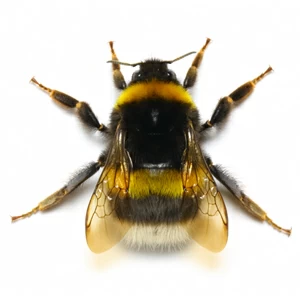
Bumble Bee
Identification Tips:
- Color: Dark reddish brown with deep yellow and brown-black markings on the abdomen. The markings on the abdomen are similar to those found on yellow jackets.
- Legs:6
- Size: 3/4 – 1 3/8 inches
- Identifying Characteristics: Fuzzy appearance; makes a loud buzzing sound when flying
Characteristics of this insect:
- Social insects live in nests and colonies. This bee may be found nesting in or around structures beneath landscape features, abandoned rodent burrows, and dense clumps of grass, and it is a concern due to the numerous bees around flowering plants.
- Adults are represented by workers, which are sterile females, queens, and males (drones), which come from unfertilized eggs in late summer.
- A mature bumble bee nest contains 50-400 bees and a brood (larva and pupae). Only drones and new queens are reared in the nest in late summer. Once new queens emerge, they mate and find a suitable place for winter. The drones, the old queen, and the unfertilized new queens die when winter arrives.
- Bumble bees will travel up to 3 miles for nectar at speeds of 7-12 mph.
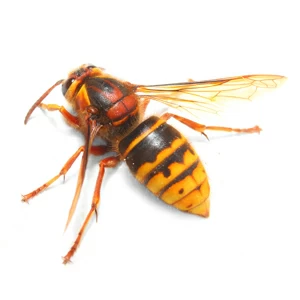
European Hornet
Identification Tips:
- Color: Brownish with yellow abdominal stripes and a pale face (looks like a giant yellow jacket)
- Legs:6
- Size:3/4 – 1 3/8 inches
- Identifying Characteristics: European hornets have a hairy thorax and abdomen. Females tend to be larger than males. Males have 7-segmented abdomens, whereas females have 6. Males have 13-segmented antennae, whereas females have 12 segments. Eyes are indented and shaped like a “C.”
Characteristics of this insect:
- Nests are typically located in a cavity such as a hollow tree or wall void but can occasionally be seen attached to structures. Nests are comprised of chewed-up cellulose from decayed wood consisting of several hundred cells, all which are enclosed in a paper envelope
- Workers can sting, but they are not particularly aggressive unless the colony is threatened
- These hornets are unique in their ability to forage at night. It is not unusual for workers to bounce off exterior lights or windowpanes during summer nights.
